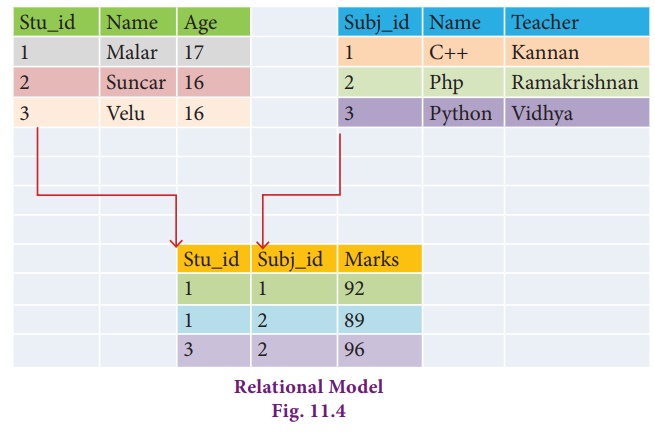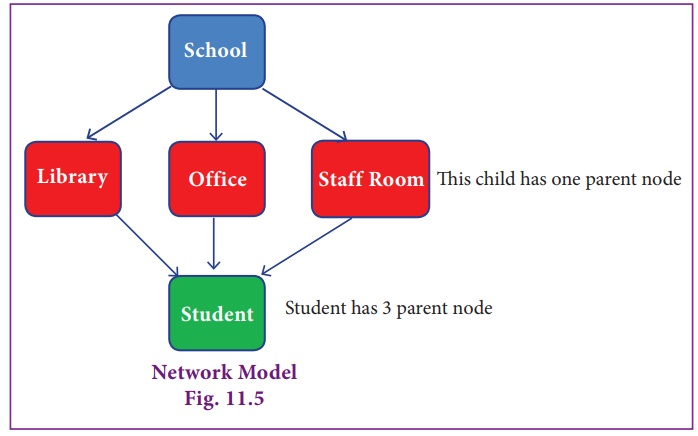Types, DBMS Users - Data Model | 12th Computer Science : Chapter 11 : Database concepts and MySql : Database Concepts
Chapter: 12th Computer Science : Chapter 11 : Database concepts and MySql : Database Concepts
Data Model
Data Model
·
A data model describes how the data can be represented and accessed
from a software after complete implementation
·
It is a simple abstraction of complex real world data gathering
environment.
·
The main purpose of data model is to give an idea as how the final
system or software will look like after development is completed.
Types of Data Model
ollowing are the different types of a Data
Model
1. Hierarchical Model
2. Relational Model
3. Network Database Model
4. Entity Relationship Model
5. Object Model
1. Hierarchical Model
Hierarchical model was developed by IBM as
Information Management System.
In Hierarchical model, data is represented as a
simple tree like structure form. This model represents a one-to-many
relationship ie parent-child relationship. One child can have only one parent
but one parent can have many children. This model is mainly used in IBM Main
Frame computers.

2. Relational Model
The Relational Database model was first
proposed by E.F. Codd in 1970 . Nowadays, it is the most widespread data model
used for database applications around the world.
The basic structure of data in relational model
is tables (relations). All the information’s related to a particular type is
stored in rows of that table. Hence tables are also known as relations in a
relational model. A relation key is an attribute which uniquely identifies a
particular tuple (row in a relation (table)).

3. Network Model
Network database model is an extended form of
hierarchical data model. The difference between hierarchical and Network data
model is :
·
In hierarchical model, a child record has only one parent node,
·
In a Network model, a child may have many parent nodes. It
represents the data in many-to-many relationships.
·
This model is easier and faster to access the data.

School represents the parent node
Library, Office and Staff room is a child to
school (parent node)
Student is a child to library, office and staff
room (one to many relationship)
4. Entity Relationship Model. (ER model)
In this database model, relationship are
created by dividing the object into entity and its characteristics into
attributes.
It was developed by Chen in 1976. This model is
useful in developing a conceptual design for the database. It is very simple
and easy to design logical view of data. The developer can easily understand
the system by looking at ER model constructed.
Rectangle represents the entities. E.g. Doctor
and Patient
Ellipse represents the attributes E.g. D-id,
D-name, P-id, P-name. Attributes describes the characteristics and each entity
becomes a major part of the data stored in the database.
Diamond represents the relationship in ER
diagrams
E.g. Doctor diagnosis the Patient

5. Object Model
Object model stores the data in the form of
objects, attributes and methods, classes and Inheritance. This model handles
more complex applications, such as Geographic information System (GIS),
scientific experiments, engineering design and manufacturing. It is used in
file Management System. It represents real world objects, attributes and
behaviors. It provides a clear modular structure. It is easy to maintain and
modify the existing code.

An example of the Object model is Shape, Circle, Rectangle and Triangle are all objects in this model.
·
Circle has the attribute radius.
·
Rectangle has the attributes length and breadth.
·
Triangle has the attributes base and height .
·
The objects Circle, Rectangle and Triangle inherit from the object Shape.
Types of DBMS Users
Database Administrators
Database Administrator or DBA is the one who
manages the complete database management system. DBA takes care of the security
of the DBMS, managing the license keys, managing user accounts and access etc.
Application Programmers or Software Developers
This user group is involved in developing and
designing the parts of DBMS.
End User
All modern applications, web or mobile, store
user data. Applications are programmed in such a way that they collect user
data and store the data on DBMS systems running on their server. End users are
the one who store, retrieve, update and delete data.
Database
designers: are responsible for identifying the data to be stored in the
database for choosing appropriate structures to
represent and store the data.
Related Topics